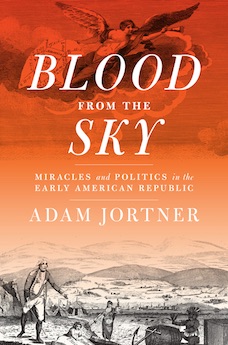By Louis J. Kern
The world of ideas and feelings in the Early Republic was neither innately rational nor Christian-centered. Rather, as Stewart Matthew has demonstrated (Nature’s God: The Heretical Origins of the American Republic), civil religion, Deism, was based on sensual perception of physical facts and grounded in pagan thought. Adam Jortner (ΦBK, College of William and Mary, 1997) provides an alternative reading of the heteroclite nature of the nation’s spiritual life in the period 1780-1838. His focus is on the “physical supernatural,” miraculous occurrences attested by eye-witness accounts—the “facticity” of miracles. He argues that those who performed, witnessed, and denied miracles operated in the same Enlightenment epistemological paradigm dominated by Scottish Common Sense philosophy, grounded in close observation, rationality, evidence confirmed by the senses, and consistency with physical nature.
The Shakers, the Mormons, and the Native American Prophets (Tenkskwatawa, Kenekuk) provide the central examples of miraculous sectarianism and wonder working charismatic figures, but Jortner offers a brief excursus on lesser known heterodox figures like the Public Universal Friend (Jemima Wilkinson). He considers the Salem witch trials and then discusses the persecution of witches among the Native Americans initiated by prophetic figures. While this discussion is interesting and does conform to the reliance on sensual evidence, a strong element of superstition and magic as opposed to the physical supernatural seems to have been at work here. Indeed, civil authorities, while misapprehending the congruence of native and white supernaturalism, considered all miraculous and prophetic manifestations as barbarian, racially and class-coded, and feminized. As such, they were disorderly, amoral, unpatriotic.
Opposition to supernatural pretensions was rooted in the need to preserve order and to insure the continuity of a republic of virtue. Ironically, Native American supernatural beliefs were designed to do precisely that in their own societies as well as to promote inter-tribal unification. Yet, White opposition to the Native Prophets offered a pretext for wars of expansion that opened native property to white homesteaders. Antagonism toward white and black supernatural expression served a similar function—to validate patriarchal dominance. Interestingly, while Jortner notes the continued existence of native supernatural sects in the present, he does not consider the Ghost Dance movement that embodied the values and practices of the earlier native prophetic tradition.
Resistence to visionary sectarians grew out of a fear that miracles implicitly challenged republicanism and threatened to create an imperium in imperio, (state within a state), an alternative government. As a consequence, miraculous sects presented a crisis for the polity. Jortner emphasizes the perceived threat of the supernatural, but does not sufficiently credit its reality for public stability. For the Shakers, the Mary Dyer and Eunice Chapman cases, in which marital ties were sundered and mothers lost access to their children, represented a very real threat to the integrity of the family, the very cornerstone of a virtuous republic. Mormons established a private militia, a paramilitary enforcement cadre (the Danites), and while in Missouri Joseph Smith virtually declared independence from the state and battled the state militia.
Jortner argues that separation of church and state and the provision of religious freedom were never intended to be ecumenical; those sects that secured safety and stability were tolerated; the heterodox were, like atheists, distrusted and persecuted.
Contra the mythic origin of the U.S. in orthodox Christianity, religion was seen as an adjunct to politics and community, not its raison d’ӗtre; it was viewed instrumentally rather than reverently. This confutes modern evangelicals’ presumption, rooted in the miraculous and supernatural, that it represents continuity with the preeminent religious form of the founding generation. Jortner’s is a significant revisionist understanding of American religious foundations and the relationship between church and state seen through the lens of supernatural sectarianism.
Louis J. Kern (ΦBK, Clark University,1965) is professor emeritus of history at Hofstra University. Hofstra University is home to the Omega of New York chapter of Phi Beta Kappa.




